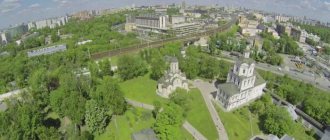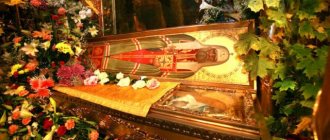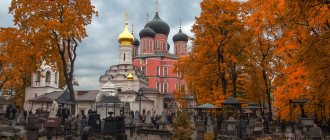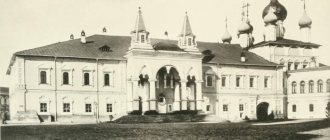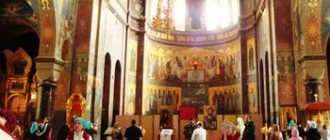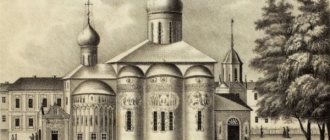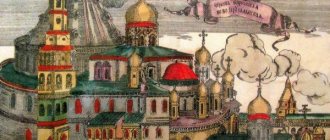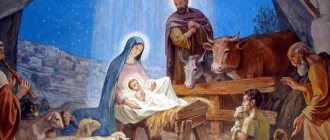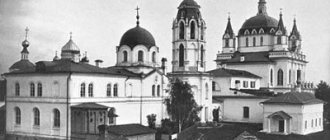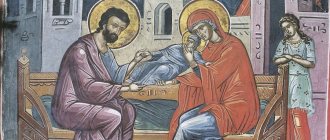Finding Zadonsk on a small-scale map is not easy: it is hidden in the bends of the Don in the center of the Lipetsk region, 70 km from the regional center and 100 km from Voronezh. People come to the city of Zadonsk for exotic things, miracles, and healing. The leisurely, soft atmosphere of the city helps us find peace and break out of the frantic circle of bustle that devours our lives. There are no high-rise buildings here; the domes of the Zadonsk monasteries dominate the area. As many as three monasteries for a tiny town of 10,000 people! Every day at church services there is a mysterious work of healing and transformation of human souls.
Y. Demyanov “Lilac May”*
*In this article we use as illustrations the amazingly beautiful paintings of the Zadonsk artist Yuri Demyanov. At the bottom of the article you will find a link to the artist’s website with a full gallery of his works, any of which can be purchased by contacting him using the contact information provided.
In addition to monasteries, guests of Zadonsk have something to see. In spring it is buried in flowers, in summer – in greenery, in autumn in the bright colors of falling leaves. And in winter, the streets of the city of Zadonsk fascinate with the charm of snow-covered antiquity. The unique sights of the city are associated with old, almost fairy-tale times - the Pottery Workshop, the Mezzanine Museum, the Kudykina Gora amusement park.
Y. Demyanov “Yard”
The expanses of Zadonsk are like a portal to the past. It returns some to a distant sunny childhood, while for others it reveals the spiritual insights of Tikhon of Zadonsk, the heavenly patron of these places.
About the city of Zadonsk
Since its inception, Zadonsk has been and remains a city attached to the Monastery. He appeared here in 1610. This was the apogee of the Time of Troubles: the Poles ruled Moscow, trying to destroy Orthodoxy and the independence of Rus'. Patriarch Hermogenes blessed the Moscow monks Kirill and Gerasim to found a new monastery on the Don. They brought here a copy of the miraculous icon of the Vladimir Mother of God. In honor of her, the first temple was built on the left bank of the Don, at the mouth of the Teshevka River. Farmers began to settle near the monks - the Teshevskaya monastery settlement was formed. The new settlement received city status a century and a half later (September 25, 1779) by decree of Catherine II, who ordered the new city to be called Zadonskaya Slobodka - or in short, Zadonsk.
Zadonsk, old postcard
Saint Tikhon breathed new life into the existence of the provincial town. After retiring from the post of Bishop of Voronezh, he lived for 15 years as a monk of the Zadonsk Monastery. The ruler's unselfishness, sacrifice, and forgiveness went beyond generally accepted norms and sank deeply into the hearts of the townspeople.
Tikhon Zadonsky
In the places of solitary prayer of the former bishop, monasteries with healing springs grew. The incorrupt relics of the saint, his canonization, a huge number of pilgrims - all this brought Zadonsk the glory of Russian Jerusalem. The town flourished until the tragic events of 1917...
Today, about 10 thousand people live in Zadonsk - exactly as many as there were in the old days. The life of the holy monasteries has been revived, the holy springs have flowed again, and pilgrims come here in any weather.
Monasteries worth visiting in Zadonsk:
- Nativity of the Virgin Mary Monastery - in the city center, at st. Communes, 14;
- Bogoroditsko-Tikhonovskaya Convent - located 3 km from the center;
- St. Tikhon's Transfiguration Convent - located 7-8 km from the city.
Historical events
Two elder monks, Kirill and Gerasim, having left their native Sretensky monastery, came to the banks of the Don, where they decided to stay forever. They brought with them their only treasure - the Vladimir Icon of the Mother of God, which gave its name to the new monastic monastery. The first small temple, built in 1630, was dedicated to her.
The monastery developed quickly, people settled around its walls, forming a peasant settlement, which was named after the Teshevka River flowing here. In 1779 it was renamed Zadonsk (“beyond the Don from Moscow”). But almost 100 years before this event, in 1692, a big disaster occurred: a fire completely destroyed the monastery, already a considerable courtyard.
Inexplicably, only one thing survived from the ashes - the Vladimir Icon of the Mother of God, which from that moment became known as miraculous. Pilgrims, wanting to touch the shrine, hurried to the fire, donating their savings to the restoration of the monastery.
After only 5 years, all the monastery buildings were restored, and the brethren began the construction of new religious buildings. In 1741, the first stone church appeared, consecrated in the name of John the Baptist, and later a slender bell tower with the Church of St. Nicholas the Pleasant in the lower floor grew. The courtyard was enlarged with cell buildings, storerooms, and was surrounded by a stone fence.
Soon the entire Orthodox world heard about the Zadonsk modest monastery again: the famous religious educator, deeply revered theologian Tikhon in the 18th century, the bishop who headed the Voronezh diocese in the last years of his ministry, decided to retire and settled in Zadonsk.
From 1769 until the day of his death in 1783, he led an ascetic, prayerful life here, wrote many works, and acquired the gift of healing. With his endless love for people, he saved souls, becoming a spiritual mentor and father for many. After his death, the number of pilgrims to his tomb increased greatly.
Half a century later, a new event occurred that left a mark on the history of the Zadonsk Monastery: the miraculous glory of the holy image of the Mother of God increased many times after the monastery’s inhabitants were saved from the plague that raged in the region in 1830-31.
Prayers were read every day before the icon of the Mother of God, and the terrible disease passed the monks by. The Zadonsky Monastery of Tikhon of Zadonsk continued its prosperity and development in the 19th-20th centuries.
The following changes took place in the area:
- A most beautiful refectory was built, lavishly decorated with sculptures and stucco patterns on the façade. Later, the magnificent structure was converted into a church.
- The two-story cell building was significantly updated.
- A hospital building appeared where hired medical specialists worked.
- In 1829-1835 a new belfry with the Church of St. Nicholas. 11 bells were installed on it, the largest of which weighed 5 tons. The mass of the next largest ones was 1.9 and 1.1 tons, respectively.
- A hotel, a pharmacy, all kinds of necessary buildings, and a church school were erected.
In 1845, construction began on the main monastery cathedral in commemoration of the Vladimir Icon of the Virgin Mary. Before the events of 1917, the monastery had 6 churches and was the owner of 2 brick factories.
The glory of the monastery reached such heights that Orthodox pilgrims going on pilgrimage to Jerusalem considered it necessary to first visit the Russian shrines: Zadonsk and Kyiv.
After the revolution, terrible times came for the monastery: holy places were desecrated, shrines with relics were opened, its inhabitants were arrested and imprisoned. Those who managed to avoid prison were left homeless. Over the years of neglect, the buildings turned into ruins: they housed vegetable production workshops and warehouses, a sausage factory, and a medical facility.
The return of the monastery to the fold of the church from the hands of the state took five whole years from 1988. The first step was to restore the main cathedral. The revived monastery celebrated its 4th anniversary in 2010 with renovated churches, newly erected buildings, veneration of believers and thanksgiving services, led by Patriarch Kirill.
Zadonsky Nativity of the Mother of God Monastery
For four centuries now, the Zadonsk Nativity of the Theotokos Monastery has stood on the left bank of the Don.
Nativity of the Virgin Mary Monastery
There are two shrines here: the Vladimir Icon of the Mother of God and the relics of St. Tikhon of Zadonsk.
Since 1610, a copy of the icon of the Vladimir Mother of God, brought from the Sretensky Monastery, consecrated the Zadonsky Monastery and glorified it with many miracles:
- In 1692 The fire destroyed all the buildings of the monastery - only the icon remained intact and unharmed. Residents were amazed by this fact. Pilgrims began to flock to the icon, everyone tried to help the revival of the monastery: some with money, some with food, some with their labor.
- In the 30s and 40s of the 19th century, cholera raged twice in Zadonsk. It did not bypass the monks either, but of those who prayed before the holy icon, not one died from the terrible disease.
- In 1861 and 1869, houses in Zadonsk caught fire again. The icon was brought with prayer to the fires - and the elements retreated, allowing people to put out the fire.
Traditionally, the Zadonsk fairs, held three times at the end of May, June and July, were associated with the patronal feasts of the Vladimir Mother of God. They caused a huge influx of pilgrims and contributed to the development of the monastery.
The main building of the monastery, the Vladimir Cathedral, is dedicated to the miraculous icon. A huge three-story beautiful temple with colonnades was erected in the middle of the 19th century according to the design of the famous architect K. A. Ton. The icon decorated with pearls and precious stones is located on the right side of the choir - this is a copy of the miraculous Vladimir icon of the Zadonsk Mother of God Monastery, restored according to descriptions. She herself, unfortunately, was lost during the Bolshevik years of hard times.
Nativity of the Virgin Mary Monastery, St. Vladimir Cathedral
The second shrine of the Bogoroditsky Monastery is the relics of Tikhon of Zadonsk. He spent the last 15 years of his life in the monastery, retiring after serving as Bishop of Voronezh.
- 1769-1783 — Tikhon lived in the Zadonsk Monastery, having acquired the gift of unceasing prayer, miracles, insight, and love for one’s neighbor; created creations that became spiritual food for many Orthodox Christians; here, in the Zadonsky Monastery, he was buried under the altar of the Vladimir Cathedral;
- 1846 - during the reconstruction of the cathedral, the body of the saint of God was found incorrupt, spontaneous popular veneration of his relics began;
- 1861 - the official canonization of Tikhon of Zadonsk took place;
- 1919 - the relics of the saint were taken from the monastery to Orel;
- August 13, 1991 - the shrine was returned to the Zadonsk Nativity of the Virgin Mary Monastery - miraculous healings resumed, documented by doctors.
A full-length image of the saint in bishop's vestments is the only icon preserved in the Nativity of the Virgin Mary Monastery in Zadonsk.
Nativity of the Virgin Mary Monastery, plan (source: oldboy.icnet.ru)
Official website of the Rozhdestov-Bogoroditsky Monastery https://zadonsk-monastyr.ru.
Activities of the complex in the 20th century
The inhabitants of the monastery met the twentieth century in a monastery with 6 churches, a religious school, a hospital, and a hotel.
Monument to Tikhon of Zadonsk at the Church of the Nativity of the Blessed Virgin Mary of the Zadonsk Monastery
The temple complex served itself, having a factory for the production of candles and 2 factories where bricks were made. Pilgrims going to the Holy Land considered it their Christian duty to first visit the Mother of God monastery in Zadonsk, Kyiv, and then go to Jerusalem.
The revolution did not spare the shrine; the relics of St. Tikhon were opened, sent to the Zadonsk museum, and then transported to Oryol.
The priesthood and monks were arrested, some were shot, and some were sent into exile.
In 1929, after the confiscation of property, the Christian shrine, which served as a refuge for the Russian people in times of trouble, was closed. An orphanage and a hospital were set up in the holy churches; vegetables were dried and sausages were made within these walls.
Revival of Russian Jerusalem
Only in 1988 did the revival of Russian Jerusalem begin; the buildings were gradually released from production and returned to the inhabitants living in several cells.
In 1991, the first post-revolutionary rite of tonsure as a monk was performed, when the monastic community accepted 5 novices. In the same year, at a gathering of thousands of Orthodox Christians, the relics of St. Tikhon were solemnly transferred to the Zadonsk Church, and after 2 years the relics of the remaining righteous were returned.
In 1998, the Patriarch of Moscow and All Rus', while visiting the temple complex, gave his Primate blessing.
2003 - all the former buildings were returned to the monastery.
St. Tikhon's Transfiguration Monastery
7 kilometers from the Bogoroditsky Monastery, on a hillside in the forest, the St. Tikhon Monastery hid from prying eyes.
St. Tikhon's Transfiguration Monastery (photo: sezenovo-mon.ru)
250 years ago, Saint Tikhon called this place “earthly paradise” - he founded a monastery here, dug a well, prayed and worked on the book “Spiritual Treasure Collected from the World.” Immediately after Tikhon’s canonization, a new monastery was founded in his honor in the wilderness on the banks of the Prokhodnya River. In 1920, the Tikhonov Zadonsky Monastery was destroyed, literally wiped off the face of the earth. But after 70 years, life began to flare up in it again. In April 1991, nuns became nuns of the “earthly paradise.” The gate church of the Transfiguration was the first to be restored, and the monastery received the name: St. Tikhon's Transfiguration Convent. On its territory there are three churches - Trinity, Preobrazhensky and Assumption, there is a hotel for pilgrims, and a bathhouse at the Holy Spring.
Y. Demyanov “Red Summer”
The revival of the monastery was accompanied by miraculous signs that strengthened the spirit of the sisters who worked for the glory of God:
- The cell of St. Tikhon arose on the site of a dilapidated turret in the wall. Once passing by it in a religious procession, all the sisters smelled the wonderful smell of incense there. It was decided to build a chapel in the corner tower in memory of Tikhon’s prayerful solitude and spiritual labors. The chapel is called the Cell of Tikhon of Zadonsk.
- The Iveron Icon of the Mother of God is an image that arrived at St. Tikhon’s Skete from Mount Athos even before the revolution. During the Soviet years, the holy icon served as a door in a barnyard until it found its way into a God-loving family. Three generations later, family members carried the holy relic and transferred it to the Tikhonovsky Monastery, not suspecting that this was its rightful place. The Iveron Icon is in the Trinity Collection - it streams myrrh, heals and gives parental happiness to childless families.
- In 2000, a Bleeding Crucifixion appeared in the Tikhonovsky Monastery: droplets of blood leaked from under the crown of thorns, on hands pierced with nails. This happened on the day of remembrance of all Russian saints. Today the wonderful relic is in the Assumption Cathedral of St. Tikhon's Monastery.
- The Stone of Health is a place to which many pilgrims come with prayer and hope for healing and receive what they ask for. It is assumed that under the stone there is a burial of the incorruptible relics of one of the former inhabitants of the monastery. The stone lies not far from the chapel on the site of the former monastery cemetery.
Today, about a hundred sisters live in the Tikhonovsky Transfiguration Monastery. Through their efforts, the place of the solitary exploits of Tikhon of Zadonsk became a real paradise on earth for many hundreds of people.
St. Tikhon's Transfiguration Monastery
Official website of the monastery https://zadonsk-skit.ru.
Development of the Zadonsk Monastery in the 18th-19th centuries.
The monastery was rebuilt and had five floors in the Russian-Byzantine style. The interior surprised with its splendor and uniqueness, wall paintings. There are scenes in them telling about the life of St. Tikhon.
The Zadonsk Monastery at the peak of its historical development had:
- large farm;
- two brick factories; estate;
- seven churches, a bell tower and other buildings.
The monastery was visited by many clergy and famous personalities, including: Saints Theophan the Hermit and Innocent; Metropolitan Isidore; Voronezh archpastors of St. Anthony; Tikhon; Zechariah and many others. The monastery was visited by Peter I, Alexander II, the senior prosecutor of the synod, and governors. At the beginning of the 20th century, the temple took the seventh place in the list of churches in Russia.
Mother of God-Tikhonovsky (Tyuninsky) Monastery
The location of this monastery is also associated with the name of Tikhon of Zadonsk, who fell in love with a spring in the wilderness, 3 kilometers from the Zadonsk Monastery. The source was ennobled and equipped by the hands of the saint - it is the main shrine of the women's monastery. In 1814, a house church was built here in honor of the “Life-Giving Spring” icon. The complex of the Tyuninsky Monastery (the name comes from the name of the landowner - the owner of these lands in the 17th century) in addition to this temple includes the majestic Ascension Cathedral, the Church of Alexander Nevsky, a four-tier bell tower, and a pilgrim's house. The monastery is home to 30 sisters, headed by Abbess Arsenia.
Mother of God-Tikhonovsky (Tyuninsky) Monastery
Official website of the Tyunin Monastery: https://tunino.ru.
Links[edit]
- Zadonsk. Zadonsky Nativity of the Mother of God Monastery. Photos and history
- Zadonsk Nativity of the Mother of God Diocesan Monastery
- Zadonsky Nativity of the Theotokos Monastery (Voronezh-Lipetsk Diocese) History on the Diveevo portal
- Zadonsky Nativity of the Mother of God Monastery. Official website of the Moscow Patriarchate
- Zadonsky Monastery: how to get there
- Zadonsky Nativity of the Virgin Diocesan Monastery. General information
- ZADONSK. Lipetsk region. Travel to holy places
Holy Trinity Convent
The beginning of the fourth Zadonsk monastery was laid by a hospice house for the care of infirm wanderers who came to worship the shrines of Zadonsk. In 1860, at the community of sisters of mercy, a church was built in honor of the icon “Joy of All Who Sorrow.” The maiden community received the status of a monastery in 1888. The people called the monastery “Sorrowful” until the Church of the Life-Giving Trinity was erected, which became the throne for the monastery.
The Holy Trinity Convent existed until 1929. Of the buildings of the former convent, only the 5-domed Church of the Life-Giving Trinity (Trinity Cathedral) remains - an architectural monument of the 19th century. This is the only place in Zadonsk where newlyweds are married and children are baptized.
Church of the Life-Giving Trinity
History of Orthodoxy in the Lipetsk region
Orthodoxy came to the Lipetsk land during the times of Kievan Rus. At the turn of the XIV-XV centuries, the entire Upper Don region, as a result of constant Mongol-Tatar raids, turned into wasteland. Only in the middle of the 16th century did the Orthodox population return here, and with the advent of the clergy and the construction of the first churches, the faith began to revive. At this time, the Zadonsky Bogoroditsky, Donkovsky Pokrovsky, Elensky Trinity Orthodox monasteries of Russia appeared. In the 17th-18th centuries, the Lipetsk region belonged to the Voronezh and Ryazan dioceses, and after, until the events of 1917, its Orthodox history is connected with the Oryol, Tambov, Tula, and Ryazan church districts. At the beginning of the twentieth century, about ten monasteries and five hundred churches operated within the modern borders of the region.
After the revolution, during the Bolshevik persecutions, most of the churches were destroyed, and the shrines acquired over the centuries were looted or destroyed. Since then, Orthodoxy on Lipetsk soil has been revived several times with the creation of the Lipetsk diocese in 1926, but constant repression and persecution of the clergy led the church to complete decline. Only in the 1980s, when the state’s attitude towards faith changed, did a new stage in the development of Christianity begin. Temples and monasteries in the vicinity of Lipetsk are being restored, and new ones are being actively built. At the same time, the real pearl of Orthodoxy of the Lipetsk region was restored - the Zadonsky Monastery.
Divine services in the monasteries of Zadonsk
The main action for which pilgrims go to Zadonsk is worship, the sacraments of Confession and Communion. The schedule of services of each monastery and church in Zadonsk has its own characteristics.
Schedule of services in Zadonsk monasteries:
| Time | Nativity of the Virgin Mary Monastery | Theotokos-Tikhonovsky Monastery (Tyunino) | St. Tikhon's Transfiguration | |
| St. Vladimir's Cathedral | Church of the Nativity of the Virgin Mary | |||
| 2:45 | Early liturgy (Sundays, holidays) | |||
| 5:40 | Sister's prayer service to Tikhon of Zadonsk | |||
| 5:45 | Middle liturgy (Sunday, holidays) | |||
| 6:00 | Morning prayers. Midnight Office. Akathist | Morning prayers. Midnight Office. Akathist to the icon "Life-Giving Spring" | Morning prayers. Midnight Office. | |
| 7:00 | Late Liturgy | Watch. Liturgy. Prayer services | ||
| 7:30 | Liturgy | |||
| 8:00 | Liturgy (Sunday) | |||
| 9:30 | Prayer service | |||
| 10:00 | Memorial service | |||
| 12:00 | Prayer service with akathist at the relics of St. Tikhon | |||
| 13:00 | Unction (Assumption Church, Saturday) | |||
| 16:00 | Evening service | Evening worship. Akathists | ||
| 16:40 | Vespers. Matins | |||
| 16:50 | All-night vigil with blessing of oil (Saturday, holidays) | |||
Advice. In all the monasteries of Zadonsk you can order services: remembrance of health and repose, magpies, prayer services with an akathist and blessing of water, the Indestructible Psalter. It is more convenient to register them on the monastery website than to stand in a long line and waste precious time during the pilgrimage.
Monastery temples and other buildings
There are several temples on the territory of the sanctuary:
- The most important, central of them is the Cathedral of the Vladimir Icon of the Mother of God. The relics of eleven saints are kept here in a marble tomb. Also here are icons with particles of the relics of the righteous. These icons were painted by the residents of the monastery, to replace old ones that were damaged or lost during difficult times, and some were brought straight from Jerusalem;
- The Church of the Icon of the Mother of God “Life-Giving Spring” was built in 2003 to replace the one that was destroyed during the revolution. Three years later, a font for believers was built here;
- The gate chapel, together with the bell tower, is under state protection and included in the list of material and spiritual values of the Russian Federation;
- The bell tower with the Church of St. Nicholas the Wonderworker was reconstructed along with the Vladimir Cathedral. Thanks to photographs, they recreated the appearance of the structure so that it looked very similar to the destroyed one. The height of the building is 80 meters;
- Church of the Nativity of the Virgin. Reconstruction began only at the beginning of the 21st century. What survived from the destroyed temple served as the basis for the construction of a new one;
- The Church of Tikhon of Zadonsk and Ignatius the God-Bearer was built in 1870 at the burial place of St. Tikhon. It is a small church made of stone;
- Church of Tikhon of Zadonsk.
Zadonsk Map
When planning to visit Zadonsk, take the time to study the city map with streets and house numbers. She will tell you a lot of interesting things about the history of the city and help create an interesting walking route.
Since the time of Catherine II, Zadonsk has been built strictly according to plan, with the streets oriented to the cardinal points. The bed of the Teshevka River divides the city into 2 parts: Northern – Dvoryanskaya and Southern – Meshchanskaya. The longest streets of the city stretch parallel to the Don from south to north: Karla Marx (formerly Dvoryanskaya Street) and st. Krupskaya (formerly Sobornaya).
The main temples of the city occupy dominant heights, reflecting the development of the city from south to north.
The Assumption Cathedral (15 Uritsky St.) is the center of the Meshchanskaya Sloboda; Zadonsk fairs were held on Market Square in front of the cathedral.
The famous “golden Lenin” stands here, pointing with an energetic gesture at the magnificent ensemble of the Bogoroditsky Monastery (Kommuny St., 14).
Following from the monastery along K. Marx Street, we see the flaming Trinity Cathedral (K. Marx Street, 85) and further on the horizon rises its twin - the Ascension Cathedral in Tyunino (beginning of K. Marx Street).
Tip: find an object on the Zadonsk route with the address: st. M. Gorky, 34. Here is an amazing landmark of the city - the Singing Oak, which streams myrrh, sings akathists and heals people. Anyone who takes the time to find this place and reach it can touch the Mystery.
Hotels in the area
Pilgrims and tourists who come to Zadonsk for a few days to visit the three monasteries located in the city have a place to stay, taking into account their desires and capabilities.
Monastery Hotel
A small monastery hotel located on the street. Lenina in house 28, offers 2 and 4-bed rooms with separate beds. Each room has a bathroom with a shower, as well as a refrigerator, microwave oven, kettle, and dishes. Bed linen is provided.
There is Wi-Fi on site and free parking for cars. Shops, cafes, a cinema, and a city park are located nearby. But the main feature is that the monastery is located 200 meters from the hotel, and a service is provided for organizing excursions to the monasteries. Room cost – from 2000 rubles.
Hotel "Zadonsk"
The hotel is located in a 3-story building built in 2010. Her address: st. Kommuny, 13. Guests are offered comfortable rooms with furniture necessary for living, air conditioning, TVs and other household appliances.
There is a restaurant with a bar, the average bill of which is 500-1000 rubles. (there is also “food in the room”), laundry, bicycle rental. For sports there is a mini golf course. Room cost from 3,000 to 10,000 rubles.
Motel "Don-424km"
There is a motel on the M4 highway, at 91 Bolshoye Panarino, where it is convenient to stay for travelers arriving in the city by car. Guests are offered comfortable rooms with modern furniture and free internet. Some rooms have air conditioning and a TV. Room price – from 1200 rub. The motel has a car repair and maintenance workshop.
The Zadonsky Monastery remembers and implements the traditions that were started by Tikhon of Zadonsky. They consist of charity, spiritual enlightenment, and merciful deeds. Monks provide care for military units of the diocese, educational and medical institutions. They provide spiritual and material support to people in need, and help in the restoration of the city’s churches.
Where to stay
The three-story Zadonsk hotel opposite the monastery is the simplest solution to the issue of spending the night in Zadonsk. It offers rooms of the “Lux”, “Comfort”, “Economy” types, costing from 750 to 5000 rubles. per person. Hotel address – st. Communes, 13.
Pilgrims of the Nativity of the Virgin Mary Monastery can stay at the hotel on Lenina, 28 - two hundred meters from the monastery. The cost of an overnight stay is 600-1000 rubles. per person.
Other accommodation options in Zadonsk can be found here.
In the monastery itself, a social hotel has been operating for almost 30 years: you can stay within the monastery walls completely free of charge, but for a short period of time. Accommodation inside the monastery provides for mandatory participation in divine services and performing feasible obediences.
Advice: if you want to attend a night monastery service, take the opportunity to spend the night in the social hotel of the Bogoroditskaya monastery. All other accommodation options will not allow you to enter the monastery territory at night.
How to get there by car, public transport
Zadonsk can only be reached by road.
By bus
The distance between Zadonsk and Moscow is 425 km. From the bus station at the Krasnogvardeyskaya metro station at intervals of 15 - 60 minutes. Buses NN 555, 1333, 979, 1396, 1335 depart, heading to Zadonsk or through Zadonsk to other cities. Travel time is up to 7 hours. Ticket price – from 935 rubles.
If you take a train to Voronezh from Kursky or Kazansky train stations (travel time 6-10 hours, cost from 678 rubles), then you will have to use an intercity bus. From the Central Bus Station of Voronezh, located on Moskovsky Prospekt, 17, a bus leaves for Zadonsk every hour. Distance – 85 km, travel time – about 2 hours, ticket price – from 250 rubles.
By car
By car from Moscow you need to travel along the M4 (Don) highway. It is impossible to drive through Zadonsk; the city is clearly visible from the highway.
By turning at the sign and crossing the Don Bridge, travelers will find themselves at the Zadonsky Monastery. They will cover the 425 km journey in 6 hours.
Saint Tikhon
The future saint and bishop was born in 1724 in the Novgorod village of Korotsko into the family of a clerk. In the world, Tikhon Zadonsky had the name Timofey Sokolov. His father Savely died early, and given that the family lived very poorly, when his son turned 14, his mother sent him to Novgorod, where Timofey was admitted to the Theological Seminary. Having demonstrated good knowledge, he was transferred to government support, and in 1754, after completing the training course, he remained to serve as a rhetoric teacher at the seminary, but thoughts about monasticism increasingly came to him. After one mysterious incident, when Timofey miraculously avoided falling from the stairs, he finally made the decision to serve God, and in 1758 he became a monk with the name Tikhon. In the same year he was elevated to the rank of archimandrite and appointed rector at the Tver Seminary.
Three years later, by decision of the Holy Synod, Tikhon became Bishop of Novgorod, and in 1763 he was sent to Voronezh. At that time, the Voronezh diocese was going through hard times: the Don steppes were inhabited by various sectarians and Old Believers, and among educated people, most of them worshiped pagan gods. There is a known case when a bishop learned about celebrations in honor of the god Yarila in the very center of Voronezh. He personally arrived at the square and made a speech, from which part of the crowd fled, and the other part knelt down asking for mercy. After this event, all pagan celebrations ceased. Taking care of attracting the population of the Voronezh lands to the Orthodox faith, Tikhon opened new schools, read sermons, and also taught his flock to honor the Church and clergy. At night he wrote his works dedicated to the Orthodox faith.
Over time, Tikhon's health began to deteriorate, and he was forced to retire, retiring to the Zadonsk Monastery and giving away all his property. But even here the saint continued to work. He wrote the books “Spiritual Treasure Collected from the World,” “True Christianity,” and “Cell Letters,” which would later play a major role in the development of Orthodoxy. Tikhon had a unique insight that allowed him to predict the war with France, the fire in St. Petersburg and the end of Napoleon. After 15 years of living in the monastery, the saint, overcome by paralysis, fell ill, but continued to pray until his last day.
In 1783, Tikhon Zadonsky died. He was buried in a special crypt under the altar in the Cathedral Church of the Zadonsk Monastery. In 1846, during construction work to restore the temple, the stone altar under which Tikhon rested was dismantled. Despite the destroyed crypt and the time that had passed since the bishop’s burial, his body remained incorrupt, as did his vestments. Archbishop Anthony of Voronezh reported this amazing fact to the Holy Synod and Emperor Nicholas I with the aim of opening the relics of the hierarch. In 1861, the opening of the holy relics of the bishop took place, which was attended by more than 300 thousand pilgrims. In the same year, Tikhon of Zadonsk was glorified as a saint.
